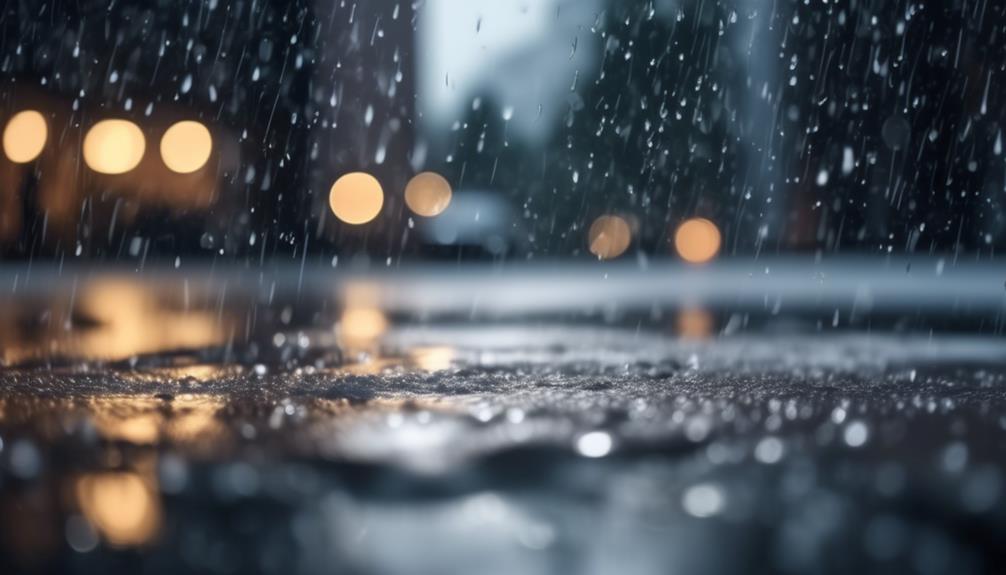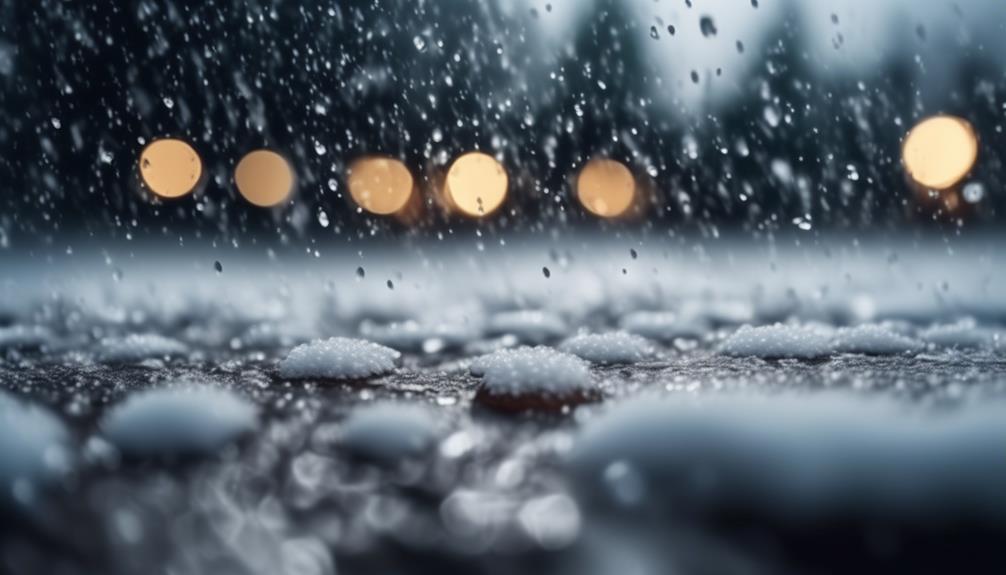Does Snow Melt When It Rains
This post contains affiliate links. As an Amazon Associate, we earn from qualifying purchases.
When rain falls on snow, it raises an interesting question: does the snow actually melt?
The interaction between rain and snow can have various implications, and understanding the dynamics of this process is crucial. Factors such as temperature, humidity, and regional climate patterns play a significant role in determining the outcome.
Exploring how rain affects snow melting and the potential consequences of this interaction can provide valuable insights into managing these environmental phenomena.
Key Takeaways
- Rain accelerates snow melting through warm temperatures, high humidity, and snowpack permeability.
- Disruption of ice crystals can occur when rain falls on snow, causing them to melt into a liquid state.
- Strong winds, high humidity, and warm temperatures intensify the melting process.
- Rain combined with existing snow cover can lead to rapid snowmelt and increased runoff, potentially causing flooding.
How Rain Affects Snow Melting
The impact of rain on snowmelt can be significant, as it accelerates the process through a combination of warm temperatures, high humidity, and the permeability of the snowpack.
When rain falls on snow, it introduces warmth, pushing the snow closer to its melting point. This increase in temperature, coupled with high humidity, facilitates the melting process.
The permeable nature of the snowpack allows the water from the rain to penetrate and move through the snow layers, further promoting melting. These conditions lead to rapid runoff, which can contribute to flooding.
In the context of climate change, the interaction between rain and snowmelt becomes increasingly relevant as changing weather patterns lead to more frequent freezing and thawing cycles, affecting the dynamics of snowpack and runoff.
Understanding how rain affects snow melting is crucial for assessing flood risks and water resource management in regions experiencing rain-on-snow events.
Factors Influencing Snow Melting in Rain

Influencing the melting of snow in rain are various factors, including the disruption of ice crystals, the impact of warm rain, high humidity levels, strong winds, and the intensifying effect of the sun's warmth.
When rain falls at warm temperatures, it can rapidly melt snow, especially if the precipitation type is predominantly rain.
High humidity levels contribute to the melting process by introducing warm moisture to the snow-covered environment, while strong winds can increase the temperature of the snow, causing it to melt faster.
Additionally, the sun's intensifying warmth plays a crucial role in accelerating the snow's melting process.
All these factors combined can effectively raise the temperature of the snow, pushing it closer to its freezing point and causing the snow to melt.
Understanding Rain and Snow Interaction
Understanding the dynamics of rain and snow interaction is essential for comprehending the complex factors influencing snow melting during rain events. This interaction is influenced by various factors such as air temperature, freezing level, and the state of the snow near the surface. When rain and snow come into contact, several important processes occur:
- Rain disrupts ice crystals and changes their conformation, causing them to melt into a liquid state.
- Warm temperatures, strong winds, high humidity, and rain can accelerate snow melting.
- Rain falling on seasonal snow cover can result in greater runoff and more destructive floods due to the combined impacts.
These processes highlight the significance of considering the intricate interplay between rain and snow in understanding the outcomes of rain-on-snow events.
Implications of Rain on Snow

During rain events, the interaction between rain and snow can have significant repercussions on hydrological systems and infrastructure. When warm air and rain combine with existing snow cover, it can lead to rapid snowmelt, increasing runoff and the risk of rain-on-snow floods. The freezing level, ground temperature, and the presence of cold air all play crucial roles in determining the impact of rain on snow.
Additionally, freezing rain during these events can cause hazardous conditions and damage to infrastructure. Forecasting flood risk during rain-on-snow events is challenging due to the complex and variable factors involved, making it essential to closely monitor temperatures and precipitation patterns.
As seen in the 2017 flood that damaged California's Oroville Dam, rain-on-snow events can result in significant damage to infrastructure, highlighting the importance of understanding their implications.
Managing Snow and Rain Interaction
Snow and rain interaction management requires a comprehensive understanding of the potential impacts of rainfall on existing snow cover and the development of effective strategies for mitigating flood risks. In mountainous regions, where snowmelt and rain can result in greater runoff and destructive floods, managing this interaction is crucial.
To effectively manage snow and rain interaction, the following strategies should be considered:
- Monitoring freezing levels and forecasting how temperatures are expected to evolve during rain-on-snow events.
- Implementing measures to reduce the impact of high humidity and strong winds which can drive snowmelt during rain-on-snow events.
- Developing reservoir management systems that can accommodate rapid runoff during rain-on-snow events, thereby reducing flood risk.
Frequently Asked Questions
Can Snow Melt in Rain?
Yes, snow can melt when it rains. The combination of warm rain and existing snowpack can accelerate the melting process, leading to increased runoff and potential flooding. This phenomenon poses challenges for forecasting and managing flood risks.
What Happens if It Rains on Snow?
When rain falls on snow, it accelerates the snowmelt process, causing rapid runoff and increasing the risk of flooding. Factors such as warm temperatures, strong winds, and saturated ground can contribute to this complex and potentially destructive phenomenon.
Will Snow Go Away if It Rains?
Snow can disappear when it rains due to increased temperatures and the added moisture from the rain. This combination can accelerate the melting process, causing snow to transition into water and eventually runoff, potentially leading to flooding in certain conditions.
What Weather Melts Snow the Fastest?
The weather that melts snow the fastest is a combination of warm temperatures and rain. Rain disrupts ice crystals, accelerating snowmelt. Additionally, strong winds and high humidity during rain-on-snow events can lead to rapid runoff and destructive floods.
Conclusion
In conclusion, rain can accelerate the snow melting process by combining with the snow and increasing runoff.
Factors such as warm temperatures, strong winds, and high humidity can also contribute to snowmelt during rain events.
The impact of rain-on-snow events can vary depending on elevation, regional climate patterns, and other factors.
Understanding the interaction between rain and snow is important for managing potential flooding and other implications of rain on snow.
